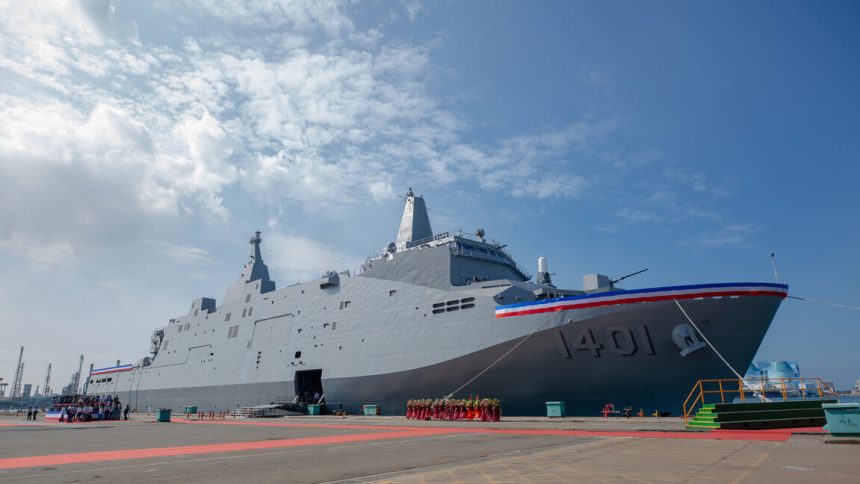About half a dozen vessels from both sides, including frigates and supply and support vessels participated in the days-long exercises that, officially, did not take place.
The US and Taiwanese navies unofficially held joint drills in the Pacific in April, in an effort to boost military coordination before China. Amid rising military threats from Beijing, whose naval and air maneuvers around the island had gotten aggressive over the last two years, the exercises conducted on what is being described as “coincidental encounters,” according to unidentified officials quoted by CNA.
While the defense and military equipment sales to Taiwan are officially declared, most of the exchanges between defense personnel on the island or in the US are kept under wraps, owing to the PRC’s (People’s Republic of China) objection to any contact with Taipei. China considers the democratically-governed island its own territory and opposes formal diplomatic interaction with Taiwan as it violates the One China policy.
The position, that Beijing has got many nations including the United States to agree to, recognizes mainland China and not Taiwan – also called the Republic of China – as the sole representative of the Chinese nation. The report describes the unplanned naval interactions to be practicing “basic” operations, which implies maneuvers of non-core combat and logistical nature.
US Navy destroyer USS Halsey (DDG-97) conducts routine underway operations while transiting through Taiwan Strait on May 8.
China PLA Eastern Theater Command organized naval and air forces to track, monitor and deal with USS Halsey’s transit.https://t.co/9e8EuQn2Uc pic.twitter.com/QRKKB1fNVk
— Ryan Chan 陳家翹 (@ryankakiuchan) May 9, 2024
‘Coincidental Meeting’
According to officials quoted in deep background, the drills took place last month in the Western Pacific involving “multiple military assets,” but officially did not exist. This is because the activities were dubbed as “unplanned sea encounters,” indicating “tacit” agreement in which both sides claim the exercises were simply the result of coincidental encounters.
About “half a dozen” vessels from both sides, including “frigates and supply and support vessels,” participated in the “days-long exercises,” the report added. These were designed to practice “basic” operations such as communications, refueling, and resupply. The exercises suggest a more logistical and information-sharing nature where in the event of high tensions with China, if the situation allows some core military coordination between RoC and the US Navies, common and standardized sailing, communication practices would ease that effort.
A strategic reason behind the elementary nature of the drills is possibly because a direct participation of US Navy vessels and aircraft in exercises with Taiwan would be perceived as near-diplomatic recognition of Taiwan and confirmation of a guaranteed US military intervention on its behalf. This might actually not deter China, but on the contrary serve to push it to carry out its invasion plans.
Opening Ceremony of the Dunmu Voyage Training Detachment in March 2024, on occassion of the 113th Anniversary of the Republic of China. Credit: RoC Navy on Facebook
Taiwan and the US have no official diplomatic relationship, as Washington formally recognises Beijing but is bound by law to provide Taiwan with the means to defend itself and is the island’s most important international backer.
Interestingly, the report mentioned the US-promoted “(CUES) Code for Unplanned Encounters at Sea,” that gives some legal basis for the interactions. The pact was signed by 21 Pacific nations at the 14th Western Pacific Naval Symposium in Qingdao, China. It is a series of non-binding rules-of-the-road to prevent an escalation of tensions between different militaries at sea. The guidelines stipulate safe speeds and distances, a common communications language and what actions to take if a ship becomes disabled. An official quoted in the report gave an analogy to describe the US and RoC Navy exercises. “It’s like I am dining in this restaurant and you also happen to be here. Then it looks like I am only sharing the same table with someone,” he said.
China Keeps Probing Taiwan
Chinese violations of Taiwan’s Air Defense Identification Zone (ADIZ) meanwhile continues.
On the morning of May 15, Taiwan’s Ministry of National Defense (MND) reported 45 People’s Liberation Army (PLA) aircraft and 6 PLA Navy vessels “operating around” the island. Of these, the “26 aircraft crossed the median line of the Taiwan Strait and entered Taiwan’s northern and southwestern ADIZ”.
45 PLA aircraft and 6 PLAN vessels operating around Taiwan were detected up until 6 a.m. (UTC+8) today. 26 of the aircraft crossed the median line and entered Taiwan’s northern and southwestern ADIZ. #ROCArmedForces have monitored the situation and responded accordingly. pic.twitter.com/d0kjfeVnDX
— 國防部 Ministry of National Defense, R.O.C. 🇹🇼 (@MoNDefense) May 15, 2024
On the morning of May 14, 10 PLA aircraft and 5 PLAN vessels in the morning and 23 PLA aircraft in various types (including SU-30, Y-8, UAVs, etc.) were detected along the southeastern coast of Mainland China and prior to that, on May 13, two PLA aircraft and seven PLAN vessels were “detected,” where the two planes crossed the Median Line. According to Reuters, the median line “previously served as an unofficial border between the two sides.” China however says it does not recognise the line’s existence, consistent with its policy of maintaining that Taiwan is its own territory and not an independent or a foreign state.
Chinese formations of aircraft flying into Taiwan’s ADIZ consist of J-16, J-11, J-10, Su-30MKK multirole aircraft, strategic bombers like the H-6, and unmanned combat aerial vehicles (UCAV) including the TB-001.









